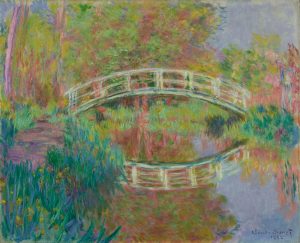In Japanese Footbridge, Giverny, Monet creates an scene that doesn’t perfectly replicate the landscape, but instead captures the essence and the feeling of the landscape. One factor that contributes to this portrayal is the visible brushstrokes. Right away, the brushstrokes show that the painting is not meant to look completely natural. Instead, the gestural brushstrokes create a sense of movement and emotion in the scene that we may not have had with blended brushstrokes. To add to this movement are the lines created by the elements of the scene that draw the viewer’s around the painting. The pathway on the left leads the viewer’s eye to the footbridge. The bridge then carries the viewer’s from left to right across the painting until it meets the reflection on the water which completes the circle, bringing the viewer’s eye back to the beginning of the path.
Another major element of the work is Monet’s use of color. Monet’s use of color gives the painting a sense of calmness and serenity. In the painting, he uses a variety of warm colors, from the reddish-browns of the tree’s reflection and trunk to the varying shades of yellow-green present throughout the leaves and grass. Even in areas dominated by cool colors, such as the flowers in the bottom left corner, there are splashes of warm colors to balance it out. Warm tones tend to connote happier emotions, although brighter ones can sometimes connote more energized or passionate emotions. Monet prevents this by using somewhat muted colors which helps to maintain a sense of peace and calmness throughout the work. Through this painting, Monet depicts the scene not as it was, but as how he felt looking at it.

Leave a Reply